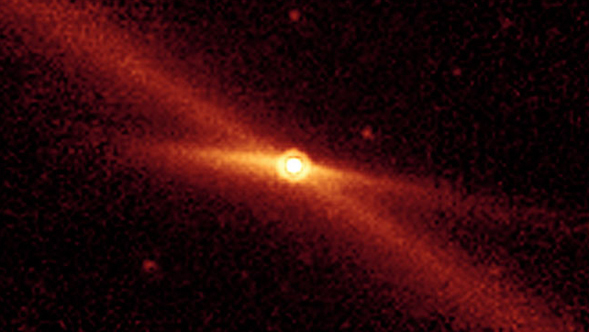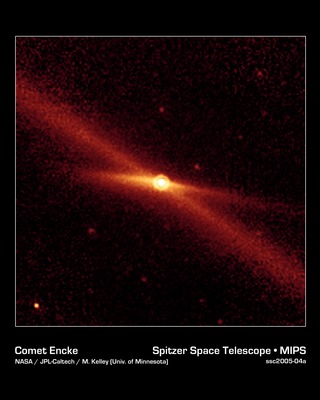
News Release • January 11th, 2005 • ssc2005-04 •
When our solar system was young, its biggest babies ”Jupiter and Saturn” threw tantrums by the trillion. The huge planets hurled ice-covered rocky bodies from the inner solar system far past the orbit of Pluto. Some of those bodies revisit their old neighborhood as "long period" comets, which have been called the Rosetta Stone of the solar system because their pristine composition holds the key to understanding how Earth and similar planets formed. Astrophysicists from the University of Minnesota and the Spitzer Science Center (California Institute of Technology) will present sharp pictures of comets and their dust trails, as well as data on comets' chemical composition, taken during the Spitzer Space Telescope's first year of operation during a poster session and press conference Tuesday, Jan. 11, at the American Astronomical Society meeting in San Diego.
Unlike the Hubble Space Telescope, Spitzer does not orbit Earth; instead, it travels behind the Earth in the same orbital path. It operates at infrared wavelengths, which enables it to see objects and material too cold to emit visible light. This is possible because even cold objects radiate heat to their surroundings as long as the surroundings are even colder. That heat is given off as infrared radiation; the cooler the object, the longer the wavelength of infrared light it emits.
The astrophysicists who will present the studies are Robert Gehrz, a University of Minnesota astronomy professor and key member of the team that focused Spitzer in orbit; Charles "Chick" Woodward and Michael Kelley, astronomy professor and graduate student, respectively, at the university; and William T. Reach of the Spitzer Science Center at the California Institute of Technology.
During their periodic sojourns into the inner solar system, comets are warmed by solar radiation and eject ices, gases and grains of rock. Included in the mix are organic materials and water, the building blocks of life, Gehrz said. By studying the infrared "signatures" of elements in comets, scientists have determined that some minerals in the dust evaporated from comet nuclei are similar to both common and unusual minerals on Earth.
"For example, comet dust may contain silica, the main ingredient in beach sand, or magnesium-rich olivine crystals, which are formed in cooling volcanic flows found on the beaches of Hawaii," Woodward said.
"Comets are leftovers from when the planets formed," said Gehrz. "Imaging their comae [the bright 'halos' around comet nuclei] and tails tells us about the content of the solar system when planets were forming. With Spitzer we can see spectral [light] details in a wide variety of comets, which has never been done before because of Spitzer's unprecedented sensitivity and range of wavelengths."
A highlight of the presentation is a study of Comet Encke, which orbits the sun every 3.3 years. Unlike more pristine comets from the netherworlds beyond Pluto's orbit, Encke has exhausted its supply of fine particles and is now giving off larger particles that are perhaps like pea gravel. After boiling off the comet nucleus, the particles tend to spread along long dust trails that follow the comet, like box cars following an engine. Every October, the Earth passes through Encke's dust trail and we witness the celestial fireworks known as the Taurid meteor shower, said Kelley.
A picture taken by Spitzer shows Encke along its bright debris trail, between the orbits of Mars and Jupiter as it headed away from the sun. Also visible are sharp twin jets of material coming off the nucleus. The images are already helping the scientists model how the rotating nuclei of comets eject particles as they travel around the sun.
The work was funded by NASA. Spitzer is managed by NASA's Jet Propulsion Laboratory in Pasadena, Calif.





